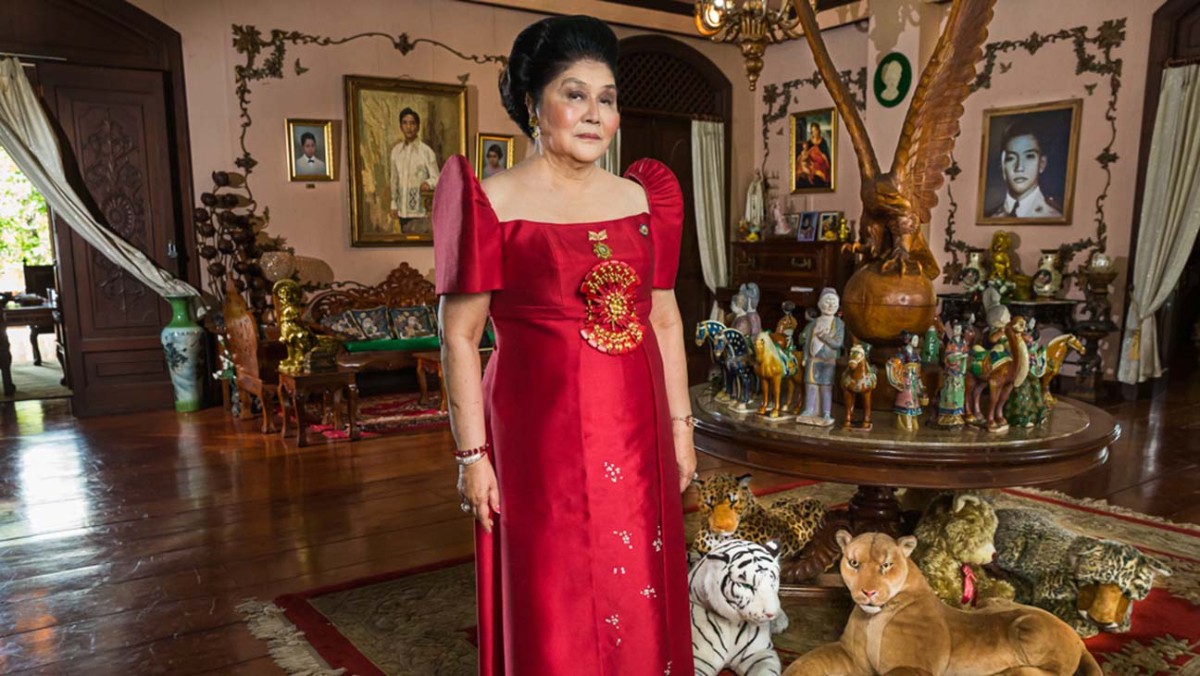It is possible, after watching Lauren Greenfield’s fascinating, necessary documentary “The Kingmaker” to believe that Imelda Marcos has so little self-awareness she does not have any idea of the extent of her absurdity. In the opening scenes, we see the onetime Evita Peron of the Philippines riding through Manila in a small bus, bouffant hairdo like a helmet. She doles out cash to people on the street with the wan boredom of a queen while reminiscing about how “in my time” the city had no beggars. Given the thickness of her rose-colored glasses, it does not seem necessary for the filmmaker or viewers to fact check that incredible claim.
Greenfield has a to-die-for subject in Marcos, and she knows it. Although a good part of “The Kingmaker” is stitched together from older news footage, Greenfield uses every opportunity to keep the camera on Marcos. One of those larger-than-life leaders from the Global South whose outsized personalities made them colorful supporting players during the Cold War’s many secondary conflicts, Marcos was a beauty queen who still maintains that always-on comportment and rigidly sunny-side messaging. Married to ambitious politician Ferdinand Marcos, she became his right-hand woman after he was elected president in 1965. Her status as traveling diplomat, illustrated by Greenfield with montages of her meeting various heads of state, was in part due to her ability to make friends with a certain class whom she still defends today. Nixon? “Misunderstood.” Qaddafi? “A friend.” But her diplomatic missions were also, as the movie acknowledges, born of necessity: Ferdinand was afraid to leave the Philippines for fear of a coup. After all, he was, like many of he and his wife’s “friends” around the globe, in essence, a dictator.
Even though there is plenty of comically extravagant footage here, particularly when the camera trails through Marcos’ palatial home, it does not take long for the dark side of “The Kingmaker” to rear up. What most people remember of Marcos are the tabloid stories about her thousands of pairs of shoes. (“A joke,” she scoffs as the camera luxuriates in her current shoe-choked closet.) Less remembered is that all those shoes, the designer gowns, the palaces, the artwork, and gaudy tchotchkes gathered with headless greed like Charles Foster Kane crating up the riches of Europe to gather dust at Xanadu, were, in all likelihood, paid for by money stolen from the Filipino people.
“I don’t remember any bad or ugly … situations,” Marcos insists. Greenfield begs to differ, laying out the backstory of how Ferdinand’s decades in power were marked not just by theft but martial law and human rights abuses whose existence barely rates a flicker in Marcos’ regal mask.
The imprisonment and likely assassination of political rival Benigno Aquino in 1983 led to the popular uprising that caused the Marcoses (on the advice and with the help, some believe, of their good friends the Reagans) to flee for their lives in 1986 and resettle in Hawaii. Within just a few years, though, Marcos had returned with her family. By the time Greenfield is filming the clan, Marcos and two of her children are holding political office—the movie’s title is a nod to the grooming of her son Ferdinand Jr. or “Bongbong” as the heir apparent—and wringing every drop of nostalgic name-recognition they can out of the memory of the late Ferdinand, whose glass-enclosed embalmed body has been lying in state for decades. In the movie’s later stretches, the cycle of demagoguery rotates to the rise of Rodrigo Duterte, whose violent repression is not just imperfectly hidden as under Ferdinand but celebrated out in the open.
Although generally a sharply humorous and incisive portrait of moral corruption, “The Kingmaker” spends, unfortunately, more time on the personal than the political. There is almost no discussion of how a leader like Ferdinand, and by extension, the other Marcoses, could still garner so much affection decades after his rule, particularly when considering the footage of rage-filled mobs storming the presidential palace. In one of the more darkly surreal touches, Greenfield interviews an inhabitant of an island that Marcos took over for a private zoo of African animals she had dumped there in 1976 and promptly seemed to have forgotten about. It’s a fitting metaphor for the unthinking damage wrought by the rich and powerful. But Greenfield stretches the point too far when she could have spent that time investigating the political dynamics causing the Philippines’ cycles of strongmen and corruption.
There is an acid touch to “The Kingmaker” that would likely surprise Marcos if she ever saw it. Marcos could have seen Greenfield’s 2012 doc “The Queen of Versailles” and imagined that its lightly comedic but generally humane take on ostentatious wealth would be a good fit for how she views herself in the world. The Marcos that she presents to the filmmaker is a beneficent and misunderstood queen who says she wants only to travel the world and bring peace, like some jewel-encrusted Dalai Lama. The Marcos that Greenfield sees is a careless and cold would-be tyrant who, when faced with a ward full of cancer patients in a clinic named for her is moved only to complain about the building’s appearance and to ask one of her assistants, “give me some money to give away.”
Maybe Marcos imagined this documentary would humanize her. Greenfield did. But not in the way that her subject would have preferred. [B]





